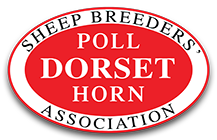INTRODUCTION
The objective of the Dorset Horn and Poll Dorset breeder is to have a flock which will lamb regularly lamb out of season and produce the maximum number of lambs for sale, either as well grown breeding ewes or as prime lambs for the current requirements of the meat trade.
To achieve this objective replacement breeding stock should be sought from flocks that have regularly lambed at the period you require for the farming calendar. Most breeders will keep precise records of their flock’s performance, thus making your selection easier.
THE FLOCK
Whatever time of year you decide to plan your lambing , make sure your ewes are not excessively fat prior to tupping. This can be achieved by intensifying the ewes onto a smaller acreage, condition score, particularly the older and less fit ewes and adjust nutrition accordingly. This will enable you to flush the ewes prior to tupping efficiently.
The rams are good workers and are particularly well suited for early covering if used in a commercial flock. Many Dorset ewes will have a slightly shorter gestation period, averaging about 145 days and the first cross females will often inherit the frequent lambing ability.
Concentrate feeding prior to lambing need normally be kept to a minimum at most times of the year. If winter lambing is decided upon then some additional feeding will be necessary either in the form of a high energy feed block, as the grass deteriorates, and then a suitable concentrated cereal feed, up to 70 gms (1.5 lbs) per day, plus roughage or roots prior to lambing.
SIRES
“The ram is more than half of the flock”, so the old phrase goes, and it is certainly as true today, if not more so in these times of tight profit margins.
Buy the best rams you can afford and look after them throughout the year. Make sure they are regularly drenched, vaccinated and their feet trimmed. Exercise is always important and do not let them become over fat.
Well before tupping check each ram over carefully and a few weeks before use increase their nutrition.
EWES
The same rules apply for the care of ewes as that of rams, and do not let them get over fat at any time particularly around lambing and weaning the lambs.
LAMBING
The Dorset Horn and Poll Dorset ewe is an excellent mother and has good milking ability. Flock Masters may need to assist, as with any other breed, hoggets lambing for the first time. Hygiene at lambing time is of paramount importance whether lambing indoors or out, and good record keeping will always assist you to make your flock as profitable and trouble free as possible.
FEEDING AFTER LAMBING
Traditionally root crop feeding or folding, with a separate creep for the lambs has been practised but more recently with the introduction of precision drilling and pre-emergent sprays etc. many incorporate main root crops like swedes or kales, together with later sowings of stubble turnips and the like. This can lend itself to various arable systems, e.g. early potatoes, winter wheat and barley breaks.
Flocks may also be maintained entirely on grass leys, the ewes utilising quality silage or hay during lactation with some concentrates being offered in severe weather conditions of if available feed lacks quality. As with traditional methods lambs should also be given creep feed.
